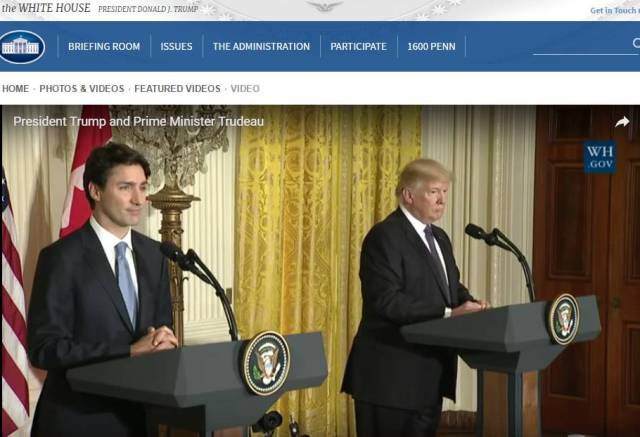 'The challenge for Canada in a renegotiated NAFTA... is to avoid being caught in the backwash'. [Picture: White House website]
'The challenge for Canada in a renegotiated NAFTA... is to avoid being caught in the backwash'. [Picture: White House website]
In his January 2017 inauguration speech, President Trump confirmed his campaign commitment to a more protectionist trade regimen for the United States, with associated ripples in the country’s foreign policies: ‘Every decision on trade, on taxes, on immigration, on foreign affairs, will be made to benefit American workers and American families’, he vowed. ‘We must protect our borders from the ravages of other countries making our products, stealing our companies and destroying our jobs.’ Among the first formal actions of the new Republican administration was a decision to withdraw from the Trans-Pacific Partnership ((TPP), which Canada had championed) and to announce the renegotiation of NAFTA, the 23-year-old North American Free Trade Agreement between the United States, Canada and Mexico.
Under President Trump, the Republican administration intends to bring about a significant disruption of the past 70 years of global trade liberalisation, seeking, in the president’s words, the ‘end of cooperation over trade’. However, the simplistic ‘America first’ electoral rhetoric and the slogans of ‘Buy American, hire American’ in the inauguration speech are now being replaced with a grudging, if unsophisticated, engagement with the complex realities of the trade and foreign policy dynamics faced by the United States. The tilt to greater protectionism in the United States (and the United Kingdom as expressed in the Brexit vote) creates new challenges and opportunities for major trading partners such as Canada. Further, as the United States steps out of its 20th century role of leading a liberalised trade agenda, it may be replaced, ironically and potentially to the chagrin of the United States, by China. It was a startling sight, for example, to see the Chinese president presenting a liberal trade agenda at the January 2017 economic forum in Davos.
For Canada, the largest trading partner of the United States and the country that shares with the United States the world’s longest, currently undefended border, a new era of trade protectionism has deep ramifications. Over US$2 billion in trade crosses the Canada–United States border daily in a trading relationship that is essentially in balance. Renegotiating NAFTA places in jeopardy jobs and investment within all three countries, Canada, the United States and Mexico. Aside from continued sore points around softwood lumber, beef product labelling, subsidies to the dairy industry, water exports, and oil pipeline construction, most would argue that NAFTA created positive investments and employment in such things as the steel industry and the auto industry that benefited all three partners. As an example, under the provisions of NAFTA, companies such as General Motors, Ford, Toyota, Volkswagen and Honda established significant investments in all three countries, generating major growth in employment and in auto parts, including, for example, in Canadian companies such as Magna International. In addition, the transfer of technology, innovation and skills across the three countries has added to overall productivity and global competitiveness.
The challenge for Canada in a renegotiated NAFTA (as well as in a newly protectionist United States agenda globally) is to avoid being caught in the backwash.



